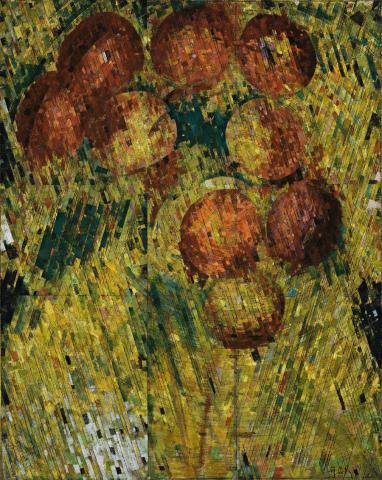APPLES, 1944-46
GODFREY MILLER
oil, pen and ink on canvas
50.0 x 40.5 cm
signed with initials lower right: G.C.M.
signed by executors on label verso: Lewis Miller, John Henshaw, John Kaplan, 8 July 1965, ref. JH90
John Brackenreg, Sydney
D.R. Sheumack, Sydney
Sotheby's, Melbourne, 25 August 1997, lot 182
Private collection, Melbourne
Godfrey Miller Retrospective Exhibition, National Gallery of Victoria, Melbourne, 10 June – 17 July 1959, cat. 17 (as 'Flowers')
The D.R. Sheumack Collection of Australian Paintings, S.H. Ervin Museum and Art Gallery, Sydney, 17 May – 12 June, 1983, cat. 80
Godfrey Miller 1893–1964, Art Gallery of New South Wales, Sydney, 15 March – 5 May 1996; National Gallery of Victoria, Melbourne, 15 May – 17 June 1996 (label attached verso, lent by D.R. Sheumack)
Henshaw, J., (ed.), Godfrey Miller, Darlinghurst Galleries, Sydney, 1965, pl. 69 (as 'Flowers')
Christie, R., and Miller, J., (eds), The D.R. Sheumack Collection: Eighty Years of Australian Painting, Sotheby's Australia, Sydney, 1988, cat. 78, pl. 78 (illus.)
Edwards, D., Godfrey Miller 1893–1964, Art Gallery of New South Wales, Sydney, 1996, pp. 40, 41, 121, pl. 27 (illus.)
The objects of Godfrey Miller's still life paintings are various fruits, flowers, and the lute, all, except the latter, things of the everyday. They are found in Still Life, Fruit and Flower (Day and Night), 1957-61 in the collection of the National Gallery of Australia, Canberra, or Still Life with Lute, 1954-56 in Sydney's Art Gallery of New South Wales. In each and more, the commonplace has been transformed into something wondrous in which aesthetic pleasure and contemplation of the universal unite. In the foreword to the memorable book on Miller published in 1965 shortly after the artist's death, Peter Bellew wrote from Paris, 'In his canvases he fought to eliminate the superficial, the irrelevant, the decorative, and to achieve absolute simplicity - basic truth.'1 Although the aim was of the highest, the pursuit is fascinating through canvas after canvas in which Miller peals back outer manifestations in search of the inner unity of all things. Apples and oranges were his preferred fruits, being of the circle, the perfect shape, form expressing unity, harmony, the whole, the universe. In each segment of colour, the macrocosm, is found in the microcosm. 'Three oranges on a tablecloth', wrote Laurie Thomas in 1960, 'could be three worlds held by the gravitation of conflicting and compensating forces in perpetual orbits.'2
Miller once wrote about, 'how a real artist makes much of a simple still life. How sincerely and with grasp, he holds or puts his thoughts on to things; he does not paint one view. As in poetry, you should run your line backwards. You should run up through the picture, should move horizontally, round, through, across. From inside the oranges, or the glass tumblers or what have you, up and down from light to dark, dark to all lights except one, dark to all light except two, from a perpendicular line to a horizontal line ... Then he knows his picture. Man has to learn to move into things with interest and step.'3 The light in his paintings is of enlightenment. The philosophies of the great masters shine out through their still life paintings, even if tucked away in a favoured corner of larger compositions. Jan van Eyck enshrined the beliefs of his age in light passing through a flask of water, the seventeenth-century Dutch provided gourmet feasts, Cézanne the structure of things, and Picasso celebrated Cubism in the objects of Parisian cafe life. While still-lifes held sway in Miller's work of the forties, his entire oeuvre is a still life in the sense of exploration in the timeless.
1.'Foreword', in Henshaw, J., (ed.), Godfrey Miller, Darlinghurst Galleries, Sydney, 1965
2. Thomas, L., 'Introduction', in Bonython, K., (ed.), Modern Australian Painting and Sculpture. A Survey of Australian Art from 1950-1960, Griffin Press, Adelaide, 1960, p. 6
3. Henshaw, J., op. cit., re. plate 4
DAVID THOMAS
